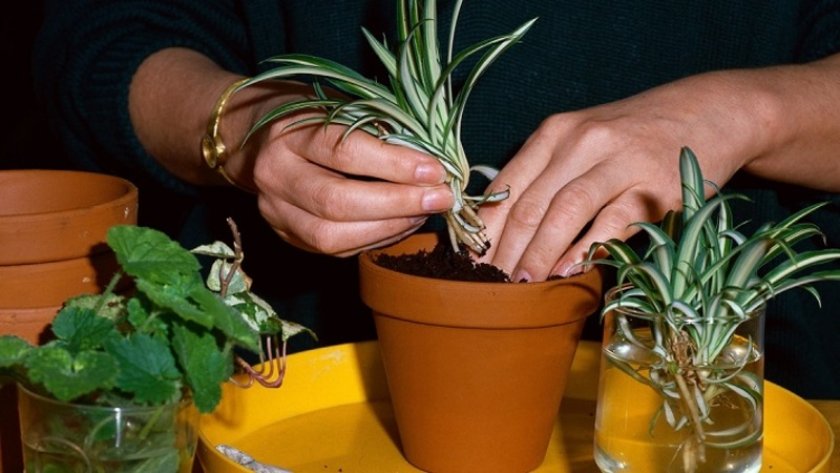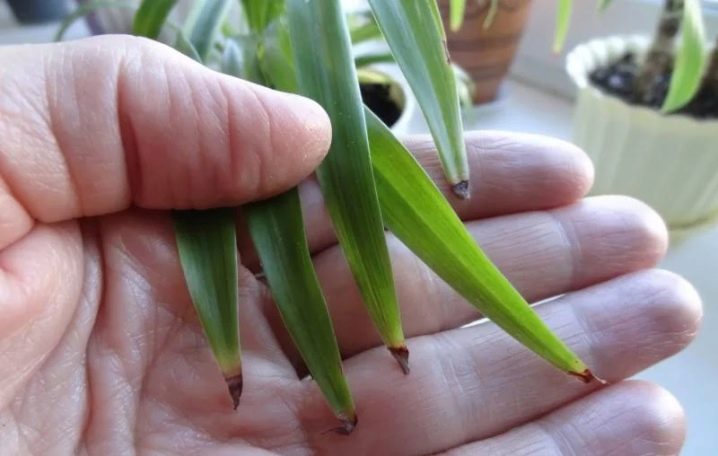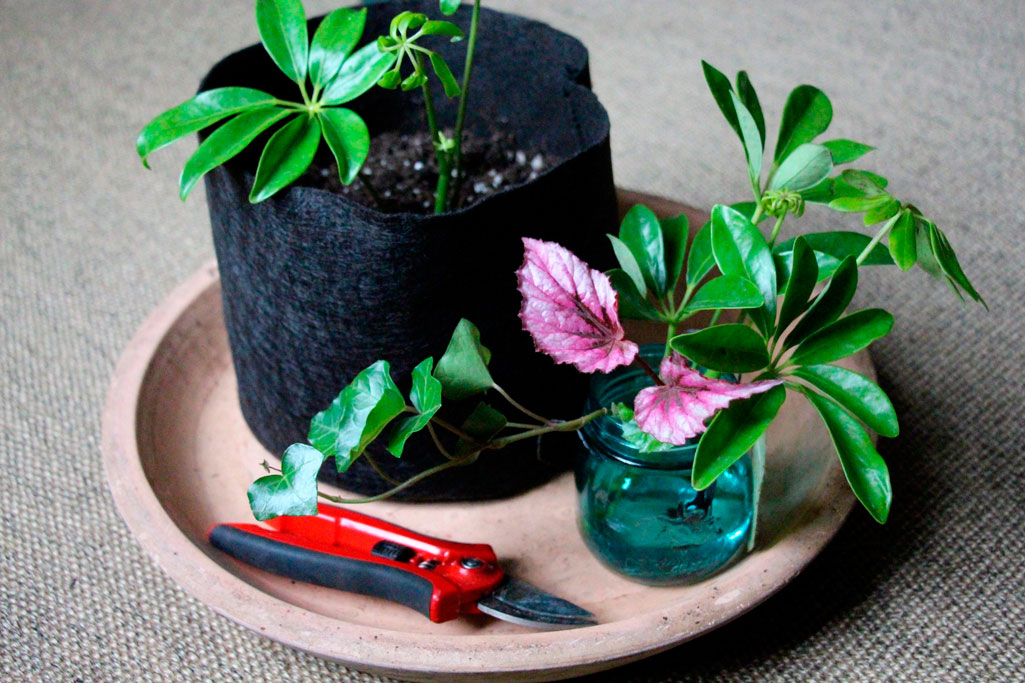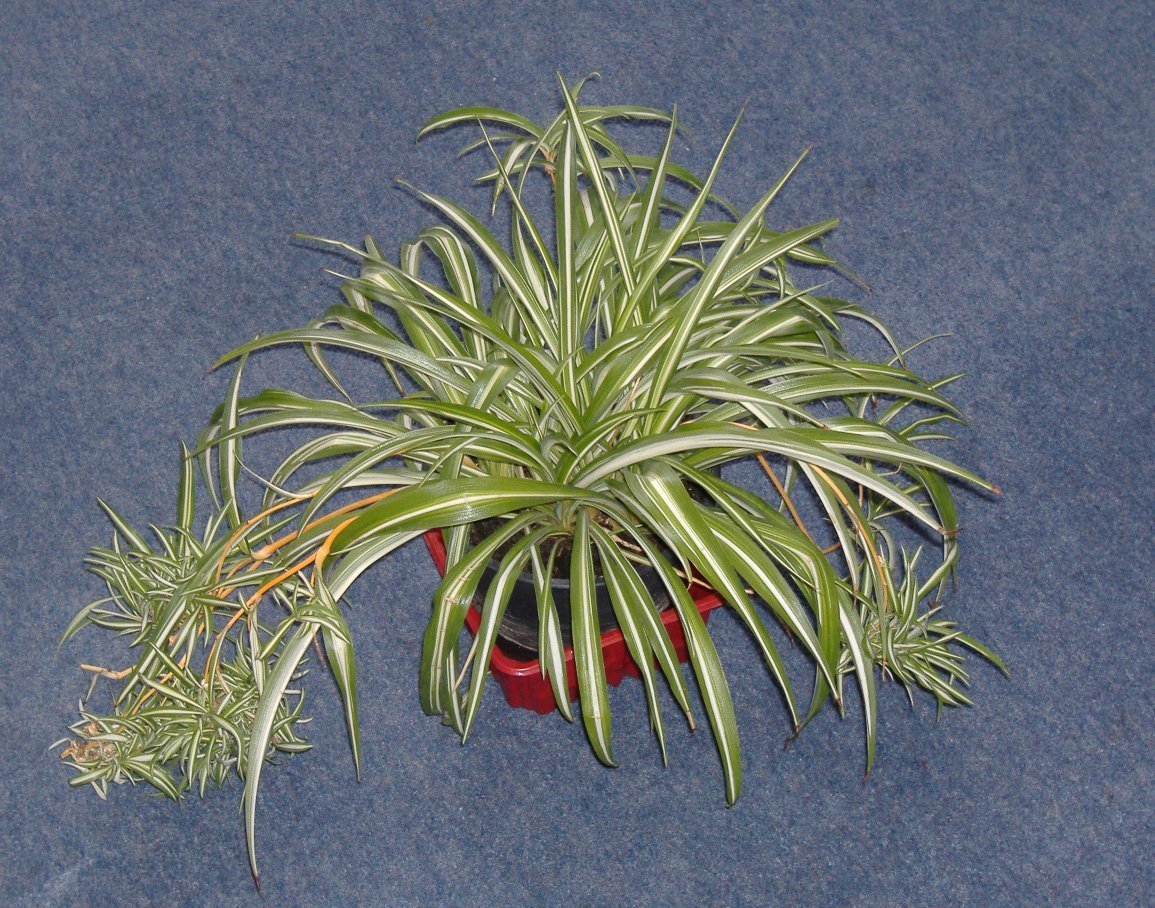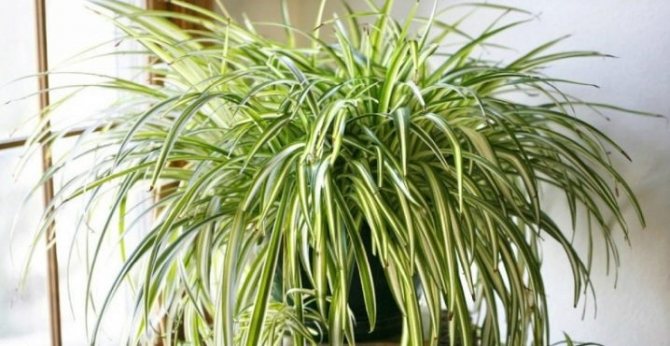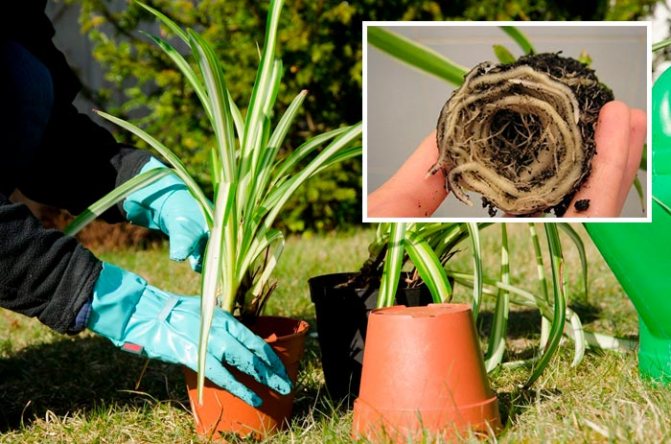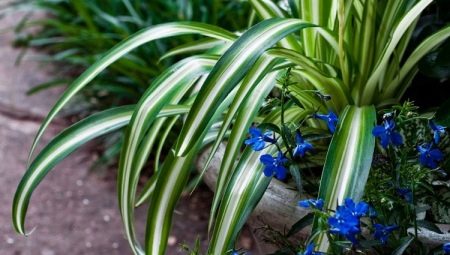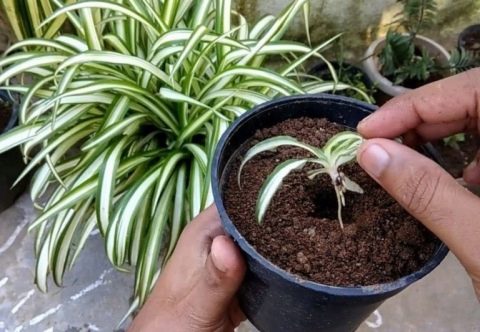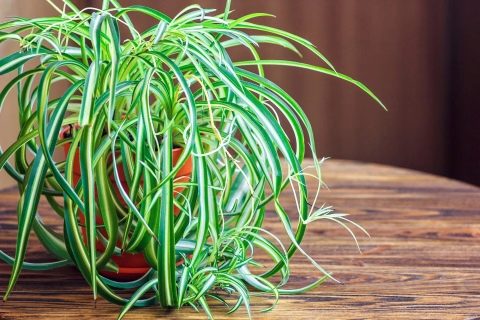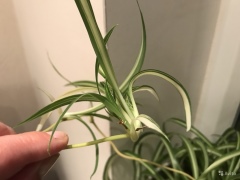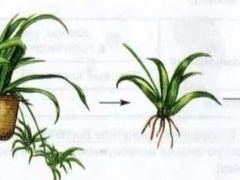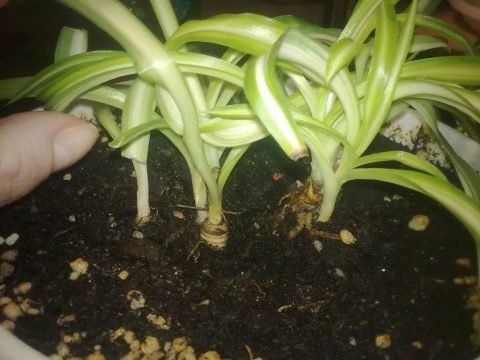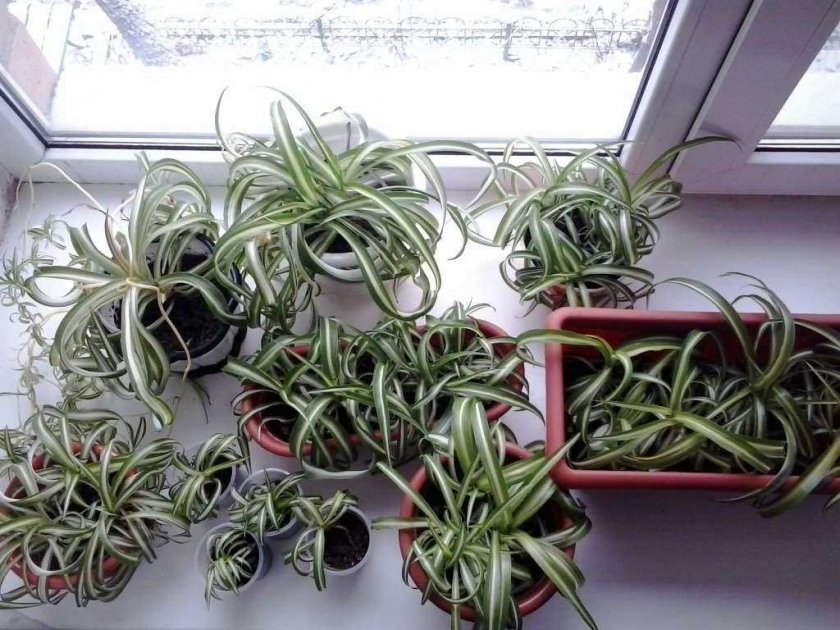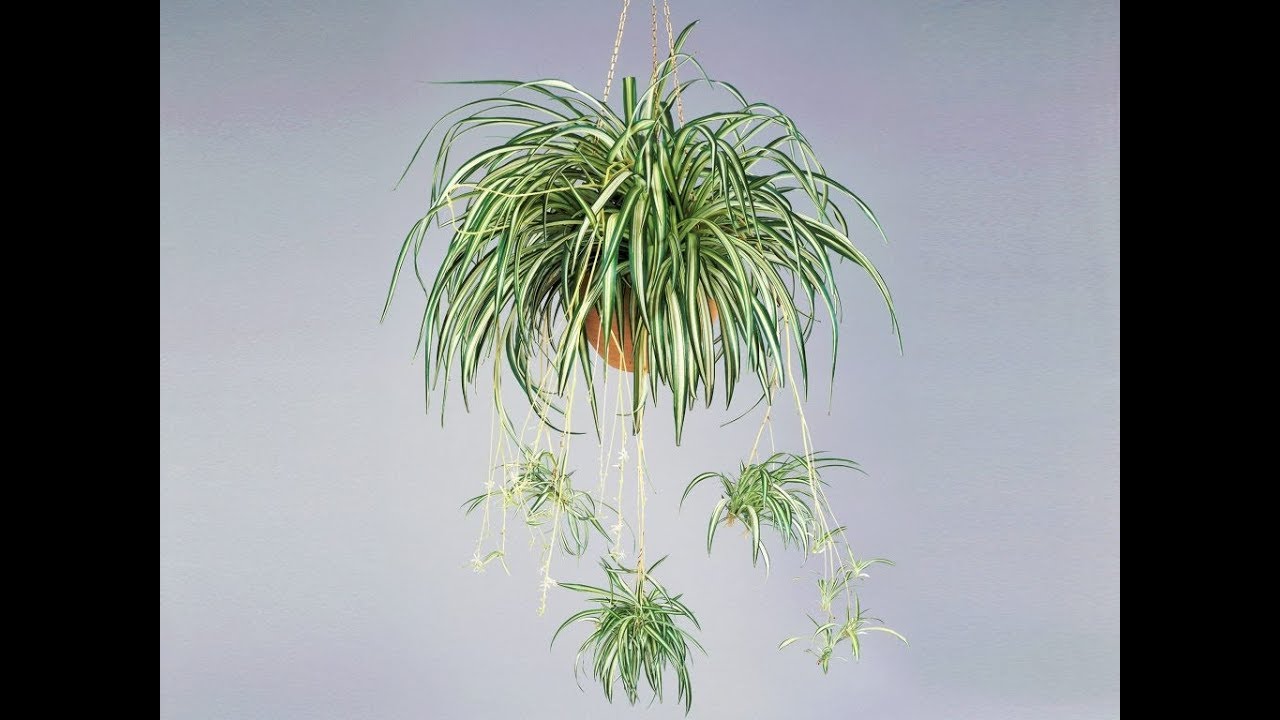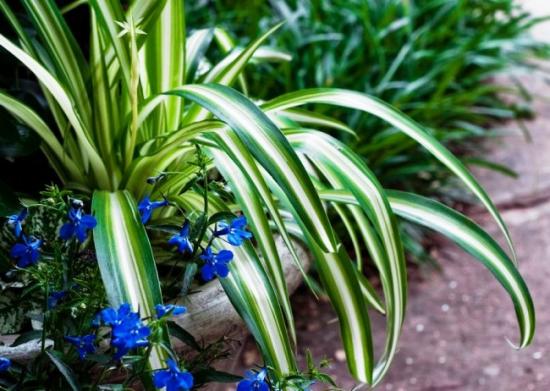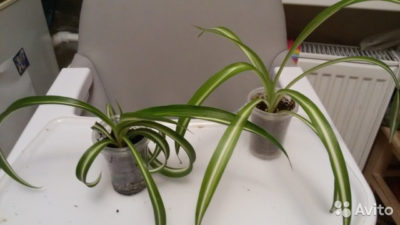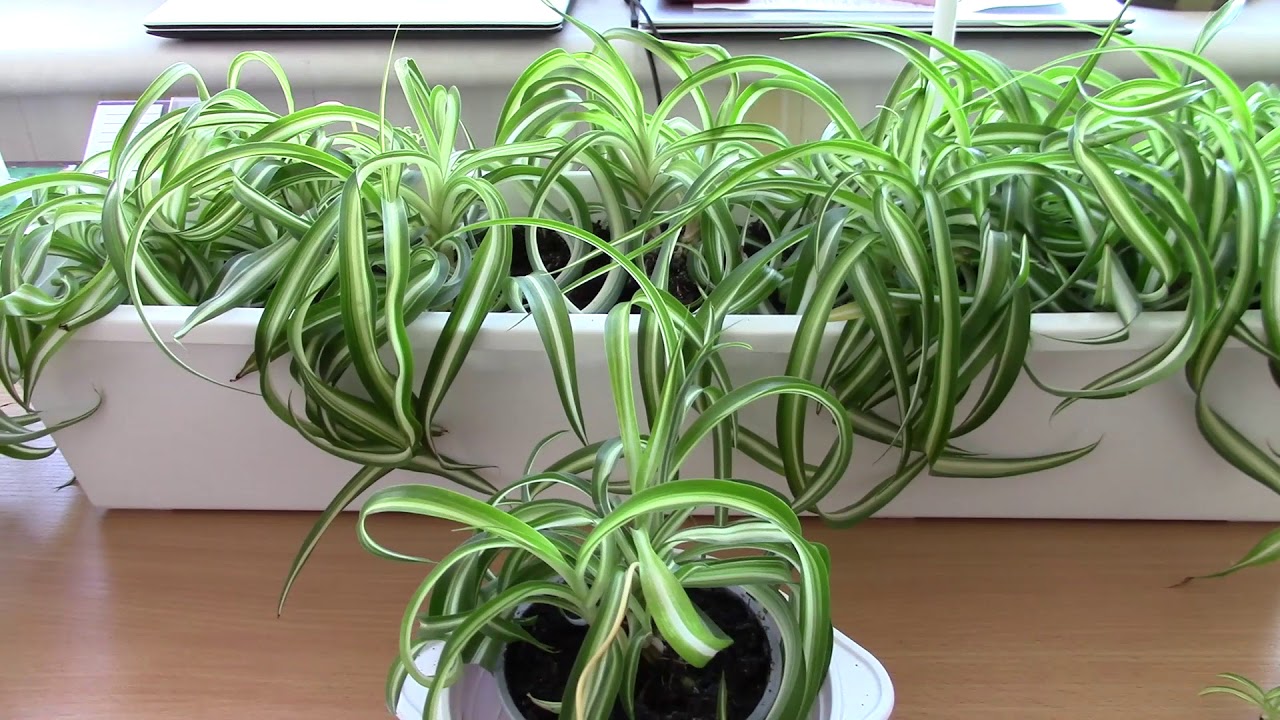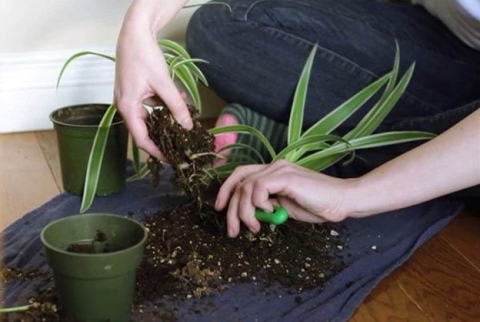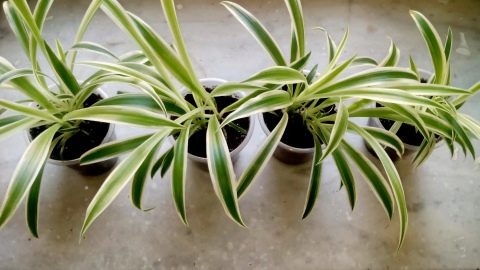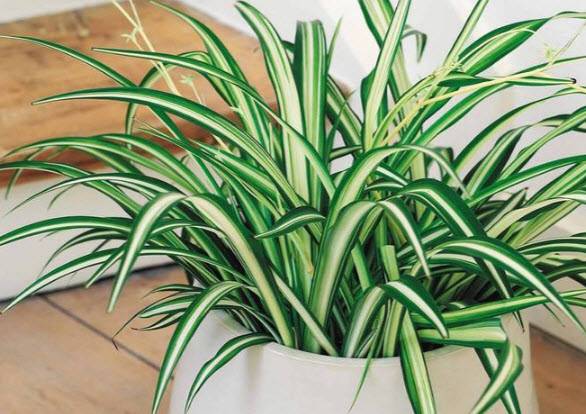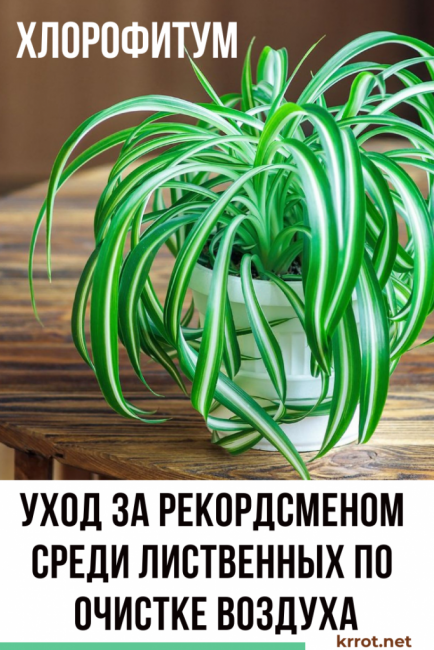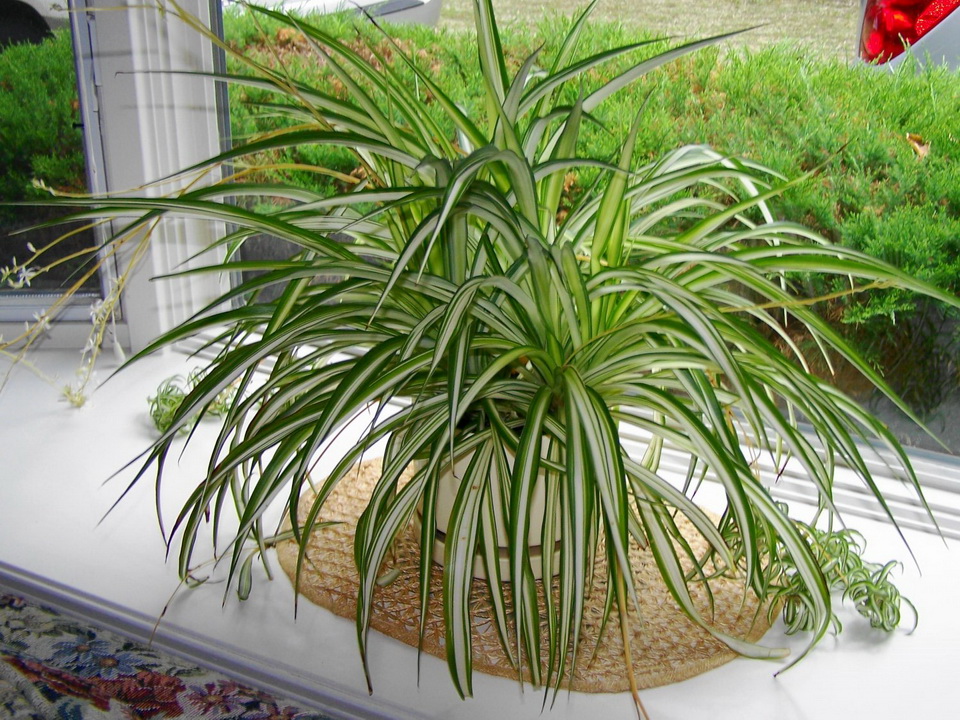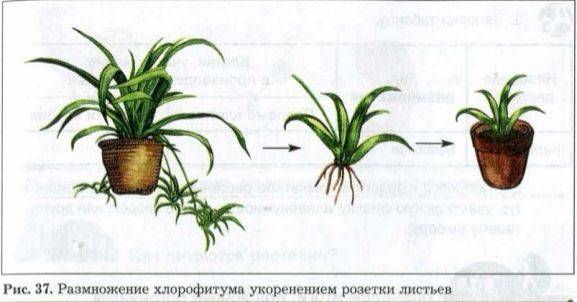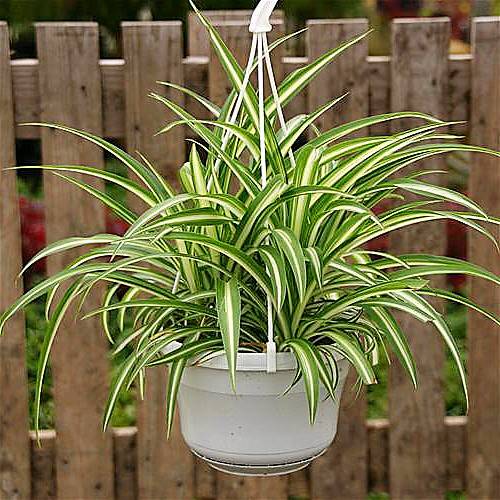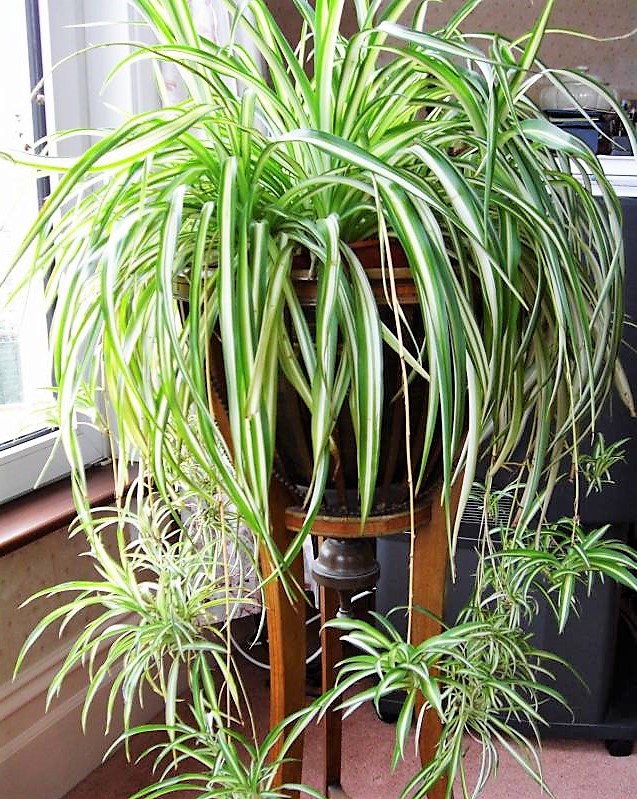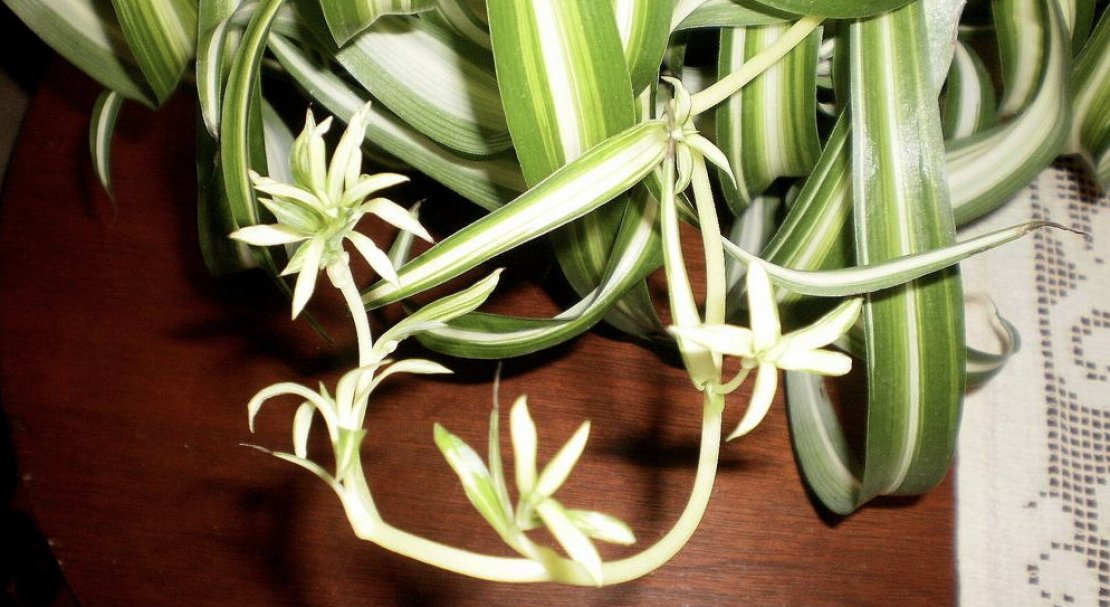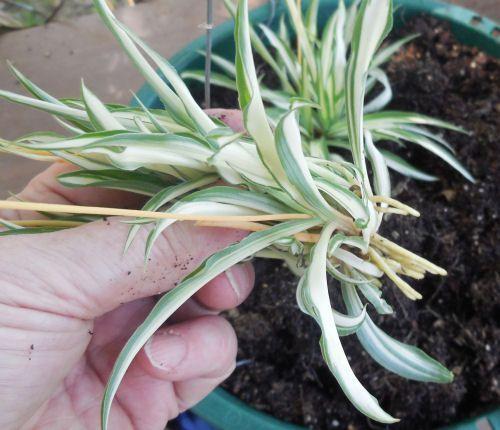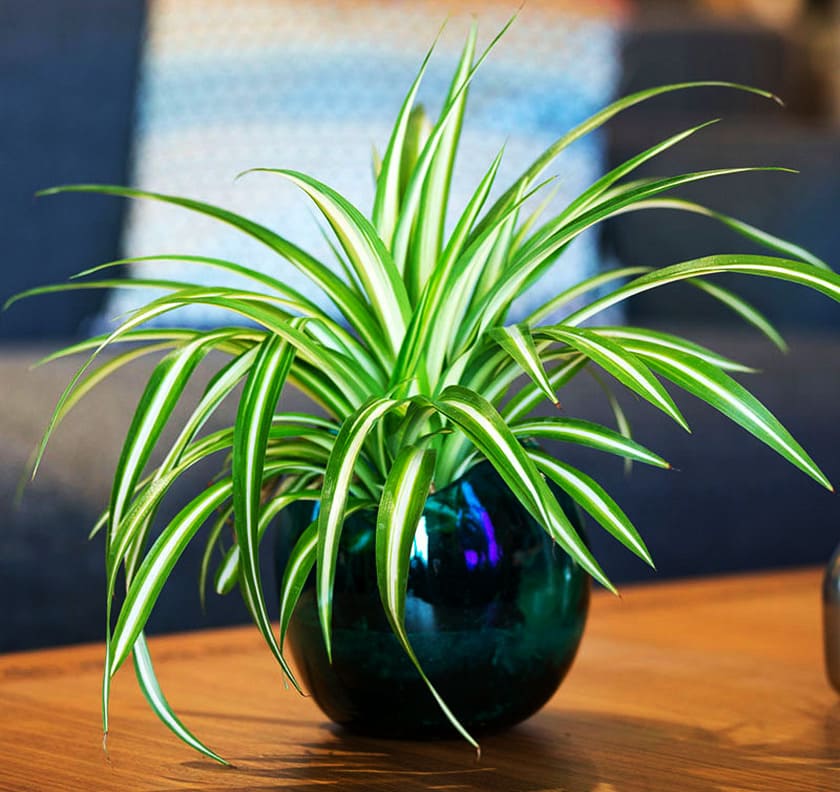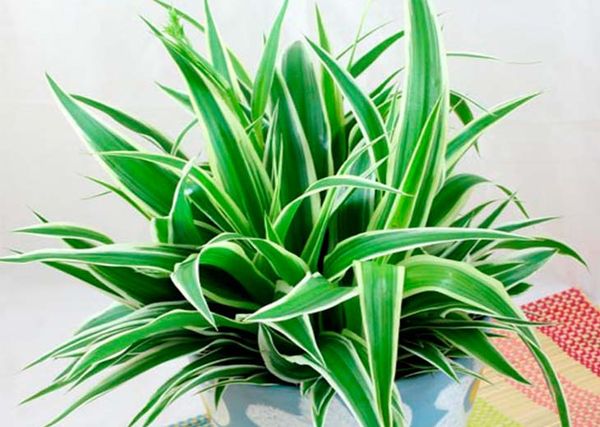Reproduction methods
Like many plants, chlorophytum can reproduce in three ways: by dividing the bush, by seeds, and by the lateral shoots (also known as babies). Planting seeds at home is not the most convenient and effective method, so it is easiest to propagate chlorophytum by dividing the bush and children, growing seeds is suitable for more experienced flower growers.
Dividing the bush
In the process of growth, chlorophytum reaches large dimensions. The pot in which the plant is contained becomes small over time. On average, once a year, it is necessary to divide the bush in order to get a new plant and give better conditions to the old one. Since chlorophytum has one of the most powerful root systems among indoor plants, its division is not difficult. The division of the bush is done only in the spring.
2-3 hours before dividing, you need to moisten the soil of the plant more than usual.
This will protect the roots and allow the procedure to be carried out quickly.
When the bush is removed from the pot, you need to free the roots from the remaining soil and carefully untangle them.
Then divide the bush into several parts. It remains to transplant the separated parts into a new container.
Reproduction by shoots
An adult chlorophytum plant forms several peduncle stems, on which rosettes are formed. Some growers note that after the separation of such children from the main plant, they should be kept in a glass of water for several days. After this, the shoots can be planted in a pot.
Before proceeding with reproduction, you should carefully choose the future dwelling of chlorophytum.
The rapid growth of this flower must be taken into account. Considering that the plant will have to live in a pot without transplants for the whole next year, you need to make sure that the container is of a suitable size
It should be noted that not all chlorophytum varieties form lateral shoots on their shoots.
Growing seeds
When preparing for the procedure, you need to understand that more than half of the seeds do not germinate at all, so you do not need to expect supernatural results. Before planting, the seeds should be covered with a thin layer of cotton wool and kept in a glass of water for a day, regularly changing the liquid to fresh (every 3-4 hours). The soil, the composition of which should contain peat and sand, must be moistened by the time the seeds are planted from cotton wool. From above, the container with seeds must be covered with glass or polyethylene. It is necessary to transfer the container to a warm and dark place and provide a temperature of 25 degrees, maintaining it constantly.
It is necessary to often open and ventilate the soil, as well as spray. After about 30 days, with proper care, sprouts will appear. By gradually increasing the airing time, after 10-14 days, the container with hatched seeds can be freed from the film.
Caring for the finished flower
Chlorophytum is an unpretentious plant that does not require much attention when leaving. But a native of the tropics still needs to create optimal conditions for full development:
Soil moisture, watering
Chlorophytum thrives in moist soil, although it can survive a short-term drought. The optimal irrigation conditions are:
- in spring and summer, the soil is moistened regularly and abundantly;
- the water drained into the pan is removed;
- young plants need frequent moisture;
- in winter, during the dormant phase, watering is reduced, preventing the earthen coma from completely drying out;
- water should be filtered or separated tap water at room temperature.
What kind of lighting is right?
Chlorophytum is not picky about the amount of light, but you should pay attention to the following conditions:
- The plant will also grow on the northern window sill.
- Optimal light conditions for him are on the east and west sides of the room.
- To preserve the color, variegated chlorophytum species should be exposed daily for 3-4 hours under diffused sunlight. Then the plants will delight the owners with bright colors and splendor of the bush.
- Prolonged exposure to sunlight leads to leaf burns.
- With a lack of lighting, the plant grows dull and loses its attractive appearance.
Fertilizing the land during transplanting
The soil mixture purchased or prepared according to the rules contains all the necessary nutrients. After transplanting, chlorophytum does not need additional feeding for 4-5 months.
During the growing season from April to September, complex fertilizers for deciduous plants are applied to the soil twice a month. Also, to increase the number of leaves, growth stimulants are added to the top dressing. Fertilizers are applied after watering to avoid root burns. In winter, during the resting phase, feeding is stopped.
How to propagate chlorophytum
The simplest breeding methods are by children and by dividing the bush. The seed method is the most laborious and rarely used.
Germinating seeds
Seed germination rate is about 30%. They are sown in spring, pre-soaking in gauze for a day. The seeds should be planted in a sandy-peat substrate, 5-7 mm deep. Then cover with foil. The greenhouse should be placed in a bright and warm place, where the temperature is 22-25 ° C). The film is opened daily to ventilate and moisten the soil from the spray bottle. Seedlings will appear in 4-6 weeks.
Seedlings are opened gradually. At first, for half an hour a day, gradually increasing the time interval. Seedlings should be planted in individual pots in the phase of 2-3 true leaves.
Rooting cuttings
In the spring, they traditionally try to transplant the flower into larger pots, and the overgrown bushes are divided into 2-3 parts. It is necessary to remove the plant from the pot, shake off the soil from the roots. Next, cut the root ball in half with a sharp knife, sprinkling the cut with crushed activated carbon. Each cut is planted in a separate pot with fresh substrate. Watering is recommended to be resumed only after a day.
For your information! Excess plots can be planted in open ground at the end of May, decorating the flower garden.
Air layering
A baby suitable for transplant is about 6-7 cm in size. Usually by this time it has several air roots. The rosette is cut from the peduncle and planted in a pot with a loose substrate. No greenhouse needed. They are looked after in the same way as for adult plants. To grow the roots, you can hold the shoot in a glass of water for some time.
 Planting baby chlorophytum should not be difficult.
Planting baby chlorophytum should not be difficult.
It is perfectly acceptable to root the rosettes without separating them from the peduncle, simply by placing a small pot next to a large one. As soon as the young leaves begin to grow, the peduncle can be cut off.
Possible growing problems and diseases
It is extremely rare for chlorophytum to cause concern to the owner if all the recommended agricultural techniques are followed.
- Drops buds and leaves. This happens due to a lack of food. This means the pot has become too cramped, and it's time to transplant the plant into a more spacious container.
- The leaves turn pale. This happens due to the excess and lack of light, as well as due to the lack of nutrients in a cramped pot. It is necessary to transplant the flower and rearrange it to a more suitable place with diffused but bright enough light.
- The tips of the leaves dry. This is the first signal that the room is too hot. At such a time, chlorophytum needs to be sprayed, and it is also bathed under the shower under a weak pressure of water so as not to break fragile leaves.
- The lower leaves fall off. This is the natural process of growing a rosette. Dry leaves must be carefully removed. If too many leaves dry out, then it's time for a transplant.
Pests
The greatest damage to the plant can be caused by:
- mealybug. Its appearance is signaled by a white, very similar to cotton wool, bloom on the leaves. They fight against the pest of actara, biotlin. Treatments are carried out after 7 days 2-3 times;
- aphid. She is attracted by tender young leaves. The appearance of aphids is signaled by twisted dried leaves in the center of the rosettes. It is recommended to treat the plant with actellik three times with an interval of 7 days;
- nematode is a very dangerous root pest. Only heat treatment will help to get rid of it. The flower is removed from the soil and the roots are washed with water at a temperature of 50-55 ° C for at least 15 minutes. Then they are planted in a clean pot with new soil.
Other problems
Juicy and fragile leaves are very fond of eating cats. Therefore, the pot should be hung higher in the planter.
Rolled leaves with brown or even black spots are a sign of sunburn. The pot should be rearranged to another, slightly shaded place. Too high air temperature and lack of water have the same consequences for foliage.
A bush littered to one side is another symptom showing that it is time to transplant the flower. When the overgrown chlorophytum is drawn to the light source, it can fall sideways under its own weight.
Planting and transplanting
For young, fast-growing plants, transplantation is carried out annually in the spring. Adult chlorophytums are less disturbed. The need arises after 2 or 3 years, with a strong growth of the flower. If you see that the roots have appeared from the drainage holes or the growth has stopped, the flowers do not appear - it's time to look for a suitable container for planting.
Chlorophytum has powerful roots that grow in width. Therefore, we choose the pot not too deep, but wider than the previous centimeters by 5. From the material, ceramic is preferable. If there are no drainage holes in the new container, you will have to make them yourself. Excessive moisture is not necessary for a plant that can accumulate moisture in the roots.

Chlorophytums grow well in short but wide pots
For chlorophytum, the composition of the soil is of paramount importance; ordinary store soil is quite suitable
But you need to pay attention to acidity. It is best to purchase a soil mixture with neutral acidity.
An acidic or alkaline earth will not work. For those who like to prepare earthen mixtures on their own, you need to take and mix the following ingredients well:
- 2 pieces of leafy land;
- 2 parts of sod land;
- 1 part of humus;
- 1 part coarse sand or perlite.

Self-made soil mixture - proof of caring for your plants
Step-by-step transplant of a houseplant
- In the selected container, be sure to lay at least 2 cm of drainage, on top of which to pour the prepared substrate.
- Grasp the rosette of the plant with your hands, carefully remove it from the old pot. In order for the process to go faster, you need to pull not vertically, but wiggle left and right.
- From the extracted plant, you need to lightly shake off the old soil from the roots.
- Then place the chlorophytum in the center of the new pot and add fresh soil mixture, filling the remaining voids.
- After planting, water the plant abundantly and remove the accumulated water from the pan. You need to put it in partial shade so that the plant adapts faster.
Growing chlorophytum in a hydrogel
In addition to soil, hydrogel is excellent for growing chlorophytum. But when using it, you need to adhere to some rules.
For planting in a hydrogel, it is best to take a young plant - the adaptation process will take place much faster than in an adult.
Before immersion in the hydrogel, the roots should be well washed if the plant was previously in the ground.
Pour water into the swollen hydrogel rarely and carefully. Do not expose the plant planted in the hydrogel to a very bright place.
Do not forget to fertilize, but rarely with a solution of weak concentration.
Periodically, the hydrogel should be rinsed in running water to get rid of a possible unpleasant odor.
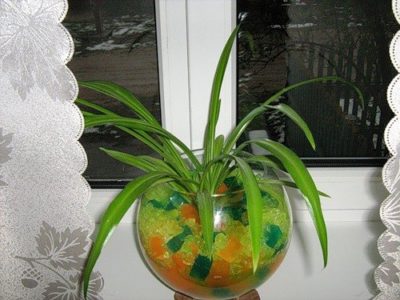
You can even grow chlorophytum in hydrogels
Chlorophytum in the interior
Flowers have always been part of the interior and chlorophytum is no exception. A versatile plant will look equally great as a soloist in a beautiful flower pot, on a stand or in a hanging flower pot, as well as in a flower arrangement with other flowers. Recently, vertical gardening is gaining great popularity. It significantly saves space, does not interfere with the penetration of light and is a stunningly beautiful decoration not only for large rooms, but also for ordinary apartments. And how good is chlorophytum with many young rosettes, a cascade surrounding an adult plant!
How to care for chlorophytum
Caring for chlorophytum at home will not cause trouble even for novice growers. Despite the fact that the homeland of this indoor plant is the tropics and subtropics, it perfectly adapted to the conditions of home windowsills. During flowering, no special care for chlorophytum is required.
Lighting
Chlorophytum prefers bright but diffused light. The most suitable for him will be windows facing west or east. However, the plant readily tolerates shading. This means that, if necessary, it can be placed on the northern windowsills or even in the back of the room (but not on the side, but opposite the window). But an excess of the sun leads to a loss of decorative value: the leaves fade, begin to dry out. In the warm season, you can take the bush out into the open air. In this case, it is located in a shady place.
Temperature regime
Unlike many indoor plants, chlorophytum grows smoothly over a wide temperature range. The optimal values for it are from 18 to 25 degrees. But the plant without "whims" tolerates summer heat, winter coolness and even drafts. The lower limit is +8 degrees. As practice shows, this flower tolerates lower temperatures for a short time.
Air humidity
For the successful cultivation of chlorophytum at home, it is necessary to maintain high humidity. The leaves are regularly sprayed; during the heating season, the plant is positioned so that the hot air from the batteries does not dry them out. It is useful to periodically "bathe" the bush under a warm shower, washing away the adhering dust. Low air humidity will not kill chlorophytum, but its leaves will begin to turn yellow and dry, losing their attractiveness.
How to water chlorophytum
Watering chlorophytum requires abundant, but without moisture stagnation. This is especially true in the spring-autumn period, when it is actively gaining green mass. In winter, the amount is reduced, but they make sure that the earthen lump does not completely dry out. The water is defended and slightly warmed up before use. Can be watered through a pallet; when watering overhead, use a long narrow watering can so as not to wet the growing point.
Due to the ability to accumulate moisture in the roots, chlorophytum can live long enough in dry soil. Drought affects it negatively - the leaves fade and die off, growth stops. Even after the resumption of regular watering, the plant “comes to life” for a long time. First, the moisture reserves in the roots are restored, and only then young leaves begin to appear. Therefore, if you are often away from home, add hydrogel to the soil. To care for chlorophytum at home, you can also use landless mixtures based on perlite - it grows well in hydroponics.
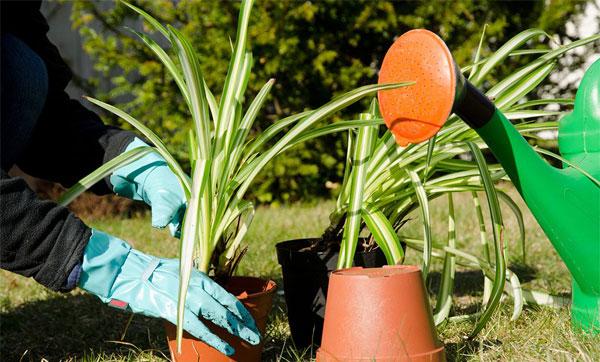
Pruning
Chlorophytum is a fast growing indoor flower and requires pruning. Dried tips and broken outer leaves are trimmed regularly. It is advisable to remove excess shoots, leaving 3-4 on the bush - they are cut off at the base. If the rosette has grown too much, the same can be done with the outer leaves without touching the central ones. The growth point can be pinched
Fertilization
Chlorophytum is fed once a month throughout the year. Use fertilizer for decorative foliage, mineral or organic. Dilute it according to the instructions on the package. In spring and summer, foliar dressings can be used - they will brighten the foliage and help the plant to survive the hot period easier.
Care after purchase
Thanks to its "vitality", caring for chlorophytum after purchase is not difficult. It is removed from the transport pot, shaken off the roots from the soil, transplanted to a new place in a fresh substrate. The root system of this flower is rarely affected by rot. Nevertheless, before planting, it is better to view it, remove damaged areas, if any, and sprinkle the cuts with crushed charcoal. It is advisable to place variegated species in a greenhouse after transplantation.
Chlorophytum transplant
Specimens that are too overgrown, about once every 2-3 years for adult specimens, need to be transplanted. Also, if you happen to pour chlorophytum in a flowerpot, where the outflow of excess water is difficult, it is better to transplant than to risk the loss of the plant.
Transplant methods
Newly transplanted plants should be watered and kept away from bright light for several days. Simultaneously with the transplant, it is advisable to trim the damaged leaves. Reducing the evaporating surface will promote better rooting in the new pot.
The flower pot should be selected taking into account the size of the root system, slightly larger than the existing earthen coma (2-3 cm larger than the actual diameter). If you are replanting an adult plant that has been growing for more than one year in the same flowerpot, you can leave the same container by gently shaking off the depleted soil around the roots along with some of the small roots (no more than one third of the total volume of the roots). This technique will promote the growth of a rosette of leaves and the development of fresh soil by a network of new young roots.
Reproduction of chlorophytum
As mentioned above, chlorophytum can be propagated vegetatively with the help of young daughter rosettes, which are formed at the ends of flowering shoots and in their internodes. Reproduction by layering is the simplest, it makes it possible to get an exact copy of the mother plant in a short period of time.
Reproduction methods
Another way of vegetative breeding is to divide the mother bush. Divide adult mother plants, greatly overgrown, at the time of transplantation. In this case, the root can be injured. Carefully cut off all damaged roots and break off some of the "old" outer leaves at the base. Place each "new" plant in your pot with a drain of ceramic shards, expanded clay, or Styrofoam slices. Fill the space around the roots with fresh soil and compact it. The neck of the plant must not be buried. It is necessary to add soil gradually after watering as it compresses.
There is another way of reproduction - generative (by seeds). Depending on the variety, the seeds have a low germination capacity. They should be sown superficially on a compacted wet substrate. Crops are placed in a greenhouse or covered with glass. It is necessary to periodically ventilate, keep in a warm room and monitor the moderate humidity of the substrate. Emerging seedlings need bright natural or artificial light. Young plants dive at the stage of 3-4 leaves in separate containers.
Reproduction of chlorophytum
The plant is propagated, ideally in the spring, in practice - as needed, when the plant is too overgrown with peduncles or the roots have already filled the entire pot and there is almost no room left for the earth.
A strong "rosette" with a leaf length of about seven centimeters can simply be dug into a nearby pot with the ground, and the stem connecting it to the main plant, without cutting it, is pressed to the ground with a hairpin. When the shoot takes root, cut the stem.
Another option is to tear off the "baby", put it in a glass of water and wait until the roots are about 2-2.5 centimeters.(The main thing is not to forget to add water to the container - growing chlorophytums love to drink). After that, plant the scion in the pot in the usual way.
Chlorophytum tolerates division during transplantation. At the same time, overgrown roots can be cut by a third - this will not affect the state of the plant in any way.
Features of caring for indoor flower chlorophytum at home

Chlorophytum is not picky about care. This grateful plant will delight not very attentive owners, if not with flowers, then with year-round greenery.
Location and lighting for the plant
Optimal for chlorophytum will be the location on the east and west windows. If the windows have a southern orientation, it is better to place the plant a little further from window sills and direct sunlight, give preference to shelves, hanging pots.
An adult chlorophytum bush looks decorative as a tapeworm (single plant) and planting in groups. It is better to plant young bushes. Over time, they will grow so as not to overshadow each other. Such a composition will look more harmonious.
Florists and phytodesigners successfully use chlorophytum when creating compositions. Due to the variety of species and varieties, with the help of chlorophytum, you can “play” on the contrast of colors or select other species in a group that are in harmony with the shape of the foliage. Most often, chlorophytum serves as the background or the lower tier of the composition.
Air humidity
Air humidity should be 40-90%. The plant tolerates dry air quite persistently during the heating season. But its development slows down during this period. It is recommended to regularly sprinkle the leaves and periodically wipe them from dust with a soft, damp sponge.
Temperature regime for a flower
Chlorophytum is a subtropical plant. In winter, it can be kept at temperatures as low as + 10-15 C0. The plant tolerates heat well.
How to properly water a flower
Chlorophytum "loves" water. To understand how you water a plant in a specific temperature and humidity, watch your specimen. Pour with settled water at room temperature so that the water completely saturates the clod of earth, and a small part seeps into the pan. The next watering will be necessary when the soil becomes slightly damp, closer to dry, on its surface. It is easy to identify by touch. Frequent surface watering will not satisfy the plant's watering needs, and overflowing can lead to sticking and rotting of the roots and growth point of your chlorophytum. In this case, it is not possible to revive the plant. In the case of chlorophytum, it is better to underfill than overflow, especially in winter. Also, due to excessive watering, long leaves break from weight.
Main features, useful properties

The option under consideration has many proven benefits. It is easy to recognize by linear leaves up to 80 cm long, most often there is a white border along the edge. There are different varieties, it is easy to highlight the main features:
- In its natural environment, it grows in the subtropics of South America, South Africa. In nature, the height and width reach a meter.
- The leaves are collected in a bunch or rosette, directed upwards, but bend, and then go down as they grow. In indoor conditions, the height does not exceed 40 cm.
- Flowers are formed on long arcuate stems. After flowering, rosettes with roots are formed at the ends, because of which Chlorophytum is often called a spider plant.
- On the roots there are tuberous thickenings in which water accumulates. Therefore, it goes through periods of drought normally, uses its own moisture reserves.
Advice! The plant feels very good in a flower pot, leaves and stolons hang down, decorating the room.
It's easier to buy for the first time, not multiply. It is better to experiment later, when there are shoots. A small bush will grow in literally a month or two, if you provide a suitable microclimate, as well as observe the watering regime.

This option is recommended to grow at home, not only because of its beautiful appearance and good omens. It has many proven benefits that can help improve the microclimate in your home. It is especially useful for city apartments. The main advantages are:
- The leaves absorb toxins, formaldehydes, carbon monoxide, and other harmful compounds from the air.
- Saturate the air in the room with oxygen, emit phytoncides that destroy pathogenic bacteria.
- They kill about 80% of all harmful microorganisms in an area of about 2 square meters. 4 plants purify the air in a room with an area of 10 sq. M.
- They absorb electromagnetic radiation from household appliances, so they grow normally even in the kitchen. Such influences do not harm Chlorophytum.
- They get along especially well with geraniums. They suck up house dust, kill harmful bacteria.
- Maintain normal air humidity by absorbing excess water or releasing it if the room is dry. Very useful for those with allergies.
The best effect is achieved at a distance of a meter from all sides, set so as to sit near the flower. It is best to place it near the places where the family spends the most time, then the benefit will be maximum.

